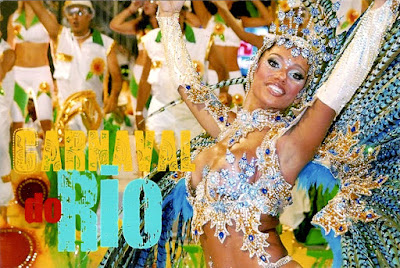January 13, 2016
2211 BRAZIL (Rio de Janeiro) - The Carnival in Rio de Janeiro
Considered the biggest festival which occurs before Lent, with two million people per day on the streets, the Carnival in Rio de Janeiro begins on Friday and ends on Ash Wednesday. King Momo, who traditionally is a tall and fat man, is the one who begin the carnival. The Queen and up to 2 princesses have the duty to woo the revelry, along with the King Momo. The carnival parade is filled with revelers, floats and adornments from numerous samba schools which are located in Rio (more than 200, divided into 5 leagues).
Every school has to follow a special order. Begins with the comissão de frente (front commission), made of ten to fifteen people, which introduces the school, and usually tell a short story. Follows the first float, abre-alas (opening wing), then the Mestre-Sala and Porta-Bandeira (Room Master and Flag Carrier), which include the old guard veterans and the ala das baianas, with the bateria at the rear and sometimes a brass section and guitars.
As the parade is taking place in the Sambadrome and the balls are being held in the Copacabana Palace and beach, many carnival participants are at other locations. Street festivals are very common during carnival and are highly populated by the locals. Elegance and extravagance are usually left behind, but music and dancing are still extremely commonas also the carnaval blocos (street bands). One of the most well known bandas of Rio is Banda de Ipanema, first created in 1965.
The carnaval costumes changed dramatically throughout time. The use of costumes and masks peaked from 1870 until the decade of 1950. They were slowly reduced, and in nowadays men prefer white trousers and sport-shirts, even shorts and bare bust, and the women wear two pieces bathing suits and a couple of ornament necklaces. After three centuries of carnaval, the bikini, and bare bust costumes also came into scene.
About the stamps
The first stamp, depicting a mail bag, was issued on 9 October, 2009. The second stamp is part of a series of 5 pieces entitled Missing Works of Portinari, issued in 2004. Candido Portinari (1903-1962) was one of the most important Brazilian painters and also a prominent and influential practitioner of the neo-realism style in painting. The third stamp is part of a definitive series representing Profissões (Professions), about which I wrote here. The last stamp, depicting a trumpet, is part of a series of ten, issued in 2002.
References
Rio Carnival - Wikipedia
Brazil Carnival - Official website
Sender: Luciano Domingos
Sent from Resende (Rio de Janeiro / Brazil), on 04.08.2014
Etichete:
AM - AMERICAS,
AM-Brazil,
BRAZIL
Subscribe to:
Post Comments (Atom)


No comments:
Post a Comment